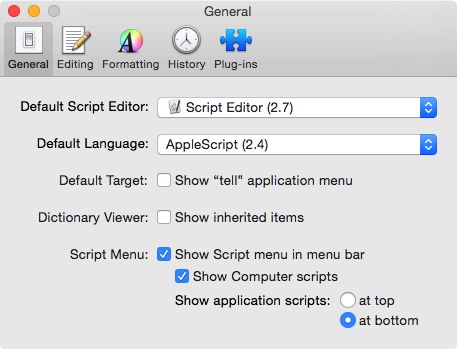Applescript In A Nutshell Best Book For Mac
Dictionaries Before scripting an application, first find out which AppleScript commands it supports. The scripter also has to know which of the target application’s objects, such as files, paragraphs, or database records, can be manipulated by a script. You can accomplish this task by selecting the program from Script Editor’s File → Open Dictionary menu command.
Applescript In A Nutshell Best Book For Mac 2016

This command displays the dialog box depicted in. Shows what the same dialog box looks like in Mac OS X. Just choose the application icon of the program that you want to examine to view its dictionary in a dictionary window. Figure 2-3. Open Dictionary dialog box in 0S 9 The application’s dictionary specifically lists the sets, or suites, of script commands and classes that the program supports (for example, the Standard Suite, AppleScript suite, or Text suite). Shows the Finder’s dictionary window in OS 9. The left panel of the dictionary window lists the application’s commands in plain text and its classes in italics.
Best Selling AppleScript Computer program language Books. Trinko Buy from $1.28 Applescript: The Definitive Guide: Scripting and Automating Your Mac Applescript: The Definitive. Applescript in a Nutshell Bruce W Perry Buy from.
Remember that commands are the messages or Apple events that a script sends an application in order to get it to do something (e.g., sleep). Classes or objects are the things that a script may try to change or get information about (e.g., a file or folder). With Safari, you learn the way you learn best. Get unlimited access to videos, live online training, learning paths, books, interactive tutorials, and more.
Scripting the Script Editor You can also use Script Editor as the target application for the Apple events sent from your script. If you are like me, you might want to begin your script in a more robust programmer’s editor, such as BBEdit. Once you are ready to test and compile the code, the following script in copies the text from BBEdit, and then pastes it into a new Script Editor window.


This applet is for demonstration purposes only and performs marginal error-trapping for the sake of brevity (it only checks to see if BBEdit has an open window). The applet has been developed under Mac OS 9 and uses the open for access, write, and close access scripting-additions commands from the Standard Additions. (Scripting additions are covered in.) Presumably, a tweaked version of this script could run on OS X; however, BBEdit had not yet released an OS X version of its text editor at the time of this writing. (.
this variable will store the BBEdit text and is initialized to a string.) set allCode to ' (. Vyprvpn for mac. this variable will store the path to the Desktop folder and is initialized to a string.) set deskPath to ' tell application 'BBEdit 5.0' try activate set allCode to (window text of document 1) on error errMessage display dialog 'Looks like BBEdit does not have any open windows' &¬ return & return & 'Error: ' & errMessage & return & return &¬ 'Exiting applet' return - this return statement.
With Safari, you learn the way you learn best. Get unlimited access to videos, live online training, learning paths, books, interactive tutorials, and more.